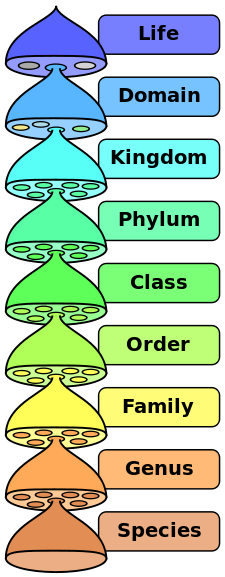Taxonomic Rankings Picture

Some "SUB" rankings:
- Class and subclass
- Order and suborder
- Family and subfamily
- Genus and subgenus
- Species and subspecies
Taxonomic Explanations
Definition: In his landmark publications, such as the Systema Naturae, Carl Linnaeus used a ranking scale limited to: kingdom, class, order, genus, species, and one rank below species. Today, nomenclature is regulated by the nomenclature codes. There are seven main taxonomic ranks: kingdom, phylum or division, class, order, family, genus, species. In addition, domain (proposed by Carl Woese) is now widely used as a fundamental rank, although it is not mentioned in any of the nomenclature codes, and is a synonym for dominion (lat. dominium), introduced by Moore in 1974.[1][2,3]
Life: Rarely used in the classification of animals.
Domain: or Empire. Sometimes used in the classification of animals.
Kingdom: Generally, scientists agree there are six kingdoms. The animal kingdom (called Kingdom Animalia) is just one of those. In case you’re interested, the others are Achaebacteria, Eubacteria, Protists, Fungi and Plants. Originally, Linnaeus only identified two kingdoms: plant and animal. Some scientists think that viruses should have their own kingdom, but currently they are not included under this system.
Phylum: Within the animal kingdom, the animals are divided into more than 30 phyla (which is the plural of “phylum”). You might be interested in Phylum Chordata — it’s the one humans and all animals with backbones are in (do you see how “chordata” looks like the word “cord” — like spinal cord?). Phylum Arthropoda contains insects, spiders and other animals with segmented bodies, like shrimp. Arthropods have their skeletons on the outside of their bodies (think of the hard shell of a lobster) and other characteristics in common.
Class: The third level of classification is class. For example, Phylum Chordata has classes in it like birds, mammals (Mammalia) and reptiles.
Order: The next level, or rank, is order. Orders are smaller groups within the different classes. Lepidoptera is the order of moths and butterflies. Carnivora is the order within Mammalia that has the most diversity in animal size.
Family: The fifth rank of classification is family. (When you get to this rank, people sometimes disagree about which family an animal belongs to, so you may find that different sources tell you different things. This can even happen with orders.) The family for dogs is Canidae.
Genus: This rank looks like “genius,” doesn’t it? It’s the second-to-last rank, and a genus may have only one or two animals in it. If animals are in the same genus, they are really closely related. In fact, you may not be able to tell them apart just by looking at them! When we write the name of the genus, we capitalize it and italicize it. For example, the genus of dogs (and wolves, too!) is Canis.
Species: If animals can breed together successfully, they are a species. When an animal is called by its scientific name, then that means it is being identified by its genus and species. We use a lowercase letter and italics for the species. The scientific name of dogs is Canis familiaris; however, the scientific name of wolves is Canis lupus.